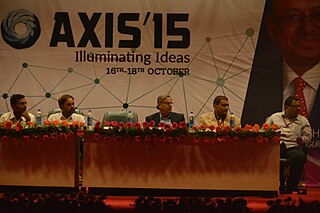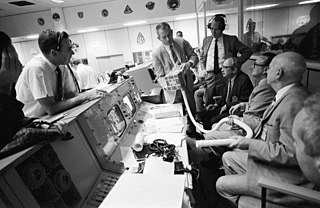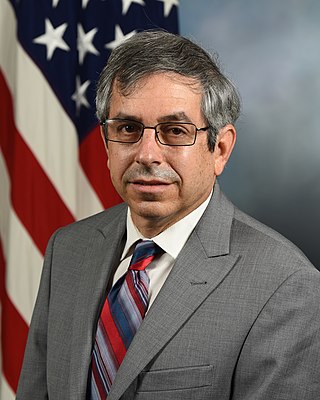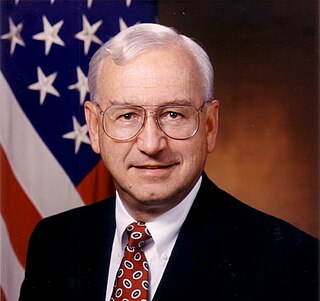Related Research Articles

Elbert Leander "Burt" Rutan is a retired American aerospace engineer and entrepreneur noted for his originality in designing light, strong, unusual-looking, and energy-efficient air and space craft. He designed the record-breaking Voyager, which in 1986 was the first plane to fly around the world without stopping or refueling. He also designed the Virgin Atlantic GlobalFlyer, which in 2006 set the world record for the fastest and longest nonstop non-refueled circumnavigation flight in history. In 2004, Rutan's sub-orbital spaceplane design SpaceShipOne became the first privately funded spacecraft to enter the realm of space, winning the Ansari X-Prize that year for achieving the feat twice within a two-week period.

The American Institute of Aeronautics and Astronautics (AIAA) is a professional society for the field of aerospace engineering. The AIAA is the U.S. representative on the International Astronautical Federation and the International Council of the Aeronautical Sciences. In 2015, it had more than 30,000 members among aerospace professionals worldwide.

Norman Ralph "Norm" Augustine is a U.S. aerospace businessman who served as United States Under Secretary of the Army from 1975 to 1977. Augustine served as chairman and CEO of the Lockheed Martin Corporation. He was chairman of the Review of United States Human Space Flight Plans Committee.

Philip Murray Condit is an American engineer and businessman who was Chair and Chief executive officer (CEO) of the Boeing company from 1996 to 2003. He dramatically reshaped the company by its merger with McDonnell Douglas and relocating Boeing's headquarters from Seattle to Chicago. He resigned to take symbolic responsibility for a military procurement scandal, although he was not accused of any ethical breaches.
Michimasa Fujino is a retired Japanese aeronautical engineer, entrepreneur, and founder of the Honda Aircraft Company, a subsidiary of the Honda Motor Company. Fujino worked as chief engineer within Honda R&D, then as vice president, before he was named the project leader for HondaJet development. He was also a Honda Motor managing officer. At Honda Aircraft, he played a crucial role in the growth of the company, and was responsible for the overall strategy of its design, development, certification, marketing, sales, and production of the HondaJet.
Jan Roskam was a Dutch-born American aircraft designer. He was the Deane E. Ackers Distinguished Professor of Aerospace Engineering at the University of Kansas. He was also the author of eleven books on airplane design and flight dynamics and over 160 papers on the topics of aircraft aerodynamics, performance, design and flight controls. He founded the company DARcorporation with Willem Anemaat.

Dinesh Keskar is senior vice president of sales in Asia-Pacific and India at Boeing Commercial Airplanes.

Aerospace engineering is the primary field of engineering concerned with the development of aircraft and spacecraft. It has two major and overlapping branches: aeronautical engineering and astronautical engineering. Avionics engineering is similar, but deals with the electronics side of aerospace engineering.

Ulfila Mark J. Lewis is a senior American aerospace and defense executive with special expertise in hypersonics. He is currently the Executive Director of the National Defense Industrial Association's Emerging Technologies Institute, following his role in the second half of 2020 as the acting US Deputy Under Secretary of Defense for Research and Engineering, and before that the Director of Defense Research and Engineering for Modernization. He was the Chief Scientist of the U.S. Air Force, Washington, D.C. from 2004 to 2008 and was the longest-serving Chief Scientist in Air Force history. He served as chief scientific adviser to the Chief of Staff and Secretary of the Air Force, and provided assessments on a wide range of scientific and technical issues affecting the Air Force mission. In this role he identified and analyzed technical issues and brought them to attention of Air Force leaders, and interacted with other Air Staff principals, operational commanders, combatant commands, acquisition, and science & technology communities to address cross-organizational technical issues and solutions. His primary areas of focus included energy, sustainment, long-range strike technologies, advanced propulsion systems, and workforce development.

Michael Ihor Yarymovych is President of Sarasota Space Associates, an aerospace consultant providing services to the aerospace industry and government. He is Senior Fellow of the United States Air Force Scientific Advisory Board (SAB) and has served on numerous SAB and Defense Science Board studies.

Wanda M. Austin is an American aerospace engineer. She is a former president and CEO of The Aerospace Corporation. She was both the first woman, and the first African-American, to hold this position. Austin also served as interim president for the University of Southern California, following the resignation of C. L. Max Nikias. She was both the first woman, and the first African-American, to hold this position.
John H. McMasters was an aeronautical engineer notable for his contributions to aerodynamics and engineering education.

Paul Garrett Kaminski is a technologist and former U.S. government official, best known for his leading role in the development of stealth aircraft.
Robert Hauschild Liebeck is an American aerodynamicist, professor and aerospace engineer. Until retiring from his position as senior fellow at the Boeing Company. in 2020, he oversaw their Blended Wing Body ("BWB") program. He has been a member of the National Academy of Engineering since 1992, where he is an AIAA Honorary Fellow, the organization’s highest distinction. He is best known for his contributions to aircraft design and his pioneering airfoil designs known as the "Liebeck Airfoil". Since his retirement he remains active in aviation industry associations and continues to teach at UCI.

Thomas John Mueller is an American aerospace engineer and rocket engine designer. He was employee No.1 of SpaceX and is the founder and now CEO of Impulse Space.

Dennis A. Muilenburg is an American engineer, business executive and a former president and chief executive officer (CEO) of Boeing, a multinational aerospace and defense company. He was CEO from 2015 to 2019, when he was fired in the aftermath of two crashes of the 737 MAX and its subsequent groundings.

Clairmont L. "Claire" Egtvedt was an airplane designer and president and chairman of the Boeing Company. Along with Ed Wells, he is considered to be the father of the Boeing B-17 bomber.

Tory Bruno is an American aerospace engineer and executive. He has been the President and Chief Executive Officer of United Launch Alliance (ULA) since August 2014. Before ULA, he worked at Lockheed Martin, where he made the transition from engineer to executive.

Joseph Majdalani is a Lebanese-American professor of Mechanical and Aerospace Engineering. He began his career at Marquette University, before serving as both the Jack D. Whitfield Professor of High Speed Flows and Arnold Chair of Excellence at the University of Tennessee Space Institute. He then served as the Auburn Alumni Engineering Council Endowed Professor and Chair, and is currently the Hugh and Loeda Francis Chair of Excellence in Aerospace Engineering at Auburn University.

Carlos E. S. Cesnik is a Brazilian-American aerospace engineer, academic, and author. He is the Clarence L. (Kelly) Johnson Collegiate Professor of Aerospace Engineering and the founding Director of the Active Aeroelasticity and Structures Research Laboratory at the University of Michigan. He also directs the Airbus-Michigan Center for Aero-Servo-Elasticity of Very Flexible Aircraft (CASE-VFA).
References
- ↑ "Boeing shares slide; investors brace for slow deliveries, profit hit". Reuters. 27 January 2016.
- ↑ "MediaRoom - News Releases/Statements".
- ↑ "Reference at www.nasampe.org".
- ↑ "Reference at www.seattletimes.com". 26 September 2011.
- ↑ "Seattle news, weather, sports, events, entertainment | seattlepi.com - seattlepi.com".
- ↑ "Air Force Space Plane to Launch After Long, Twisted Past | Space". Space.com . 4 April 2010.
- ↑ "Reference at aviationweek.com".
- ↑ "Boeing: Executive Biographies".
- ↑ "Boeing: Executive Biographies".
- ↑ "Boeing: Executive Biographies".
- ↑ "Reference at science.house.gov" (PDF).[ permanent dead link ]
- ↑ "Hearings - U.S. Senate Committee on Commerce, Science, & Transportation".
- ↑ "MediaRoom - News Releases/Statements".
- ↑ "Boeing Celebrates 100 Years of World-Changing Achievement and Launches Second Century of Innovation - Jul 15, 2016".
- ↑ "NAE Website - Dr. John J. Tracy".
- ↑ "Reference at www.aiaa.org".
- ↑ "Reference at www.galcit.caltech.edu".
- ↑ "Reference at www.asme.org" (PDF).
- ↑ "Reference at www.aiaa.org" (PDF).
- ↑ "Boeing Executive Earns Hispanic Engineer Award - Oct 10, 2006".
- ↑ "Reference at www.greatmindsinstem.org". Archived from the original on 2016-07-26. Retrieved 2016-07-27.
- ↑ "US Black Engineer – The STEM Community's Magazine". Archived from the original on 2016-09-16. Retrieved 2016-07-27.
- ↑ "Reference at www.usnews.com".
- ↑ "Reference at www.nasampe.org".